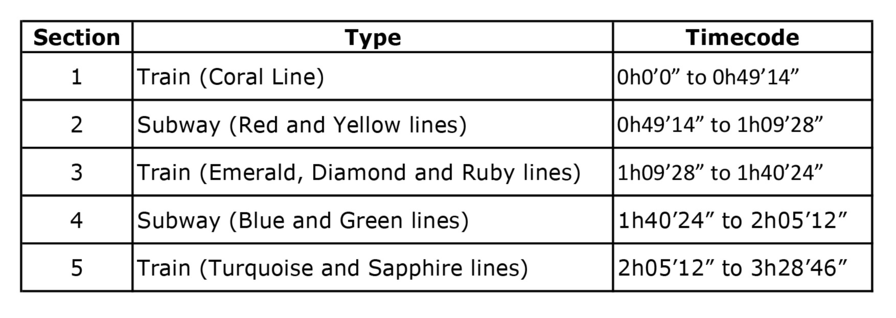Sound Differences
From the sound recording, it was possible to analyze the recording according to its sonic qualities related to the type of transport (train or subway) and to the characteristics of the sound recorded during the transportation. For this analysis the final audio was divided into five sections, according to the type of transport (train or subway), as shown in Table 2. The segments on trains are substantially longer than those on the subway: the shortest stretch on a train (31m) is longer than the longest one on the subway (25m). The longest train section lasts 1h23m, reflecting the fact that the railway lines were built to connect different cities while the subway lines were created to connect the neighborhoods of São Paulo.
Section 1 starts at the easternmost point of the railway network, Calmon Viana Station in the city of Poá. The ground level train line brings suburban workers to downtown São Paulo. The stations are further from each other, which makes the recording times between them longer.
In terms of sound, the almost 50m-long stretch presents some characteristics that are standard on trains: the sound signal for doors closing consists of a series of seven to ten short beeps depending on the line; voice announcements indicating upcoming stations are made shortly before arriving, and a variety of voice announcements during the commute focus mainly on denouncing harassment, correct use of reserved seats, passenger positioning on the train and the prohibition of vendors in the carriages.
In the first part of section 1 there are few external noises, and the rhythmic sound of the train’s wheels on the tracks and private conversations between passengers are in the foreground. At 11m, at Antonio Gianetti Neto station on the border between the municipalities of Ferraz de Vasconcelos and São Paulo, the first street vendors appear, offering mainly candies and sweets. At 24m the motion noises intensify, mostly metallic whistles, and the vendors reappear, now selling peanuts and headphones. From 33m on, when the train becomes an express, with 11m between two stations, the speed increases, creating a correlating increase in the noise. The vendor sounds disappear, and what stands out is the conversations between passengers.
Section 2, made in central São Paulo, introduces some features of the subway: all announcements are bilingual (Portuguese and English); the announcement regarding the subsequent station is made immediately following departure and not shortly before arrival at that station, as on trains; there are fewer voice announcements on the trip; the journey time between stations defaults to around 2m, and the warning for closing doors is a single long beep. The subway train makes very little noise, and there are few conversations between passengers. There are no vendors on this stretch. At 52m, at Sé central station, there is an increase in cellphone use, and at the next station the noise made by the train’s movement increases. At 56m, when switching to the Yellow line (managed by a different company than the other subway lines), some standards change: once again the announcement for the next station is delivered close to arrival, and the warning for closing doors is a saxophone recording. This line is noisier than the others, for the most part due to the sounds of the train’s movement, metallic whistles, and the wheels on the tracks.
Section 3, made on trains, begins on the Emerald line, built alongside the Pinheiros River. In the open air, above ground, noises from the train’s movement are reduced, but there are also fewer conversations going on between passengers. Only when switching to the Diamond line, at 1h24m, do the vendors appear again, this time peddling their wares of water, soft drinks, cellphone chargers, and USB sticks. At 1h26m, a vendor, caught by surprise at the arrival at Domingos de Moraes station, tells the passengers: “Guys, we have arrived at the station. Due to the guard’s presence in the carriage, I'm no longer selling USB sticks but instead giving a talk on global warming.” Until the end of this line, sellers continue offering various products such as food, candy, and padlocks. Parallel conversations between passengers also increase.
In Section 4, the Blue line is the noisiest, due to both passenger conversations as well as the noises made by the train’s movement. At 1h40m, between Luz and São Bento stations, occurs the sole incident of a vendor on the subway, selling sweets. The switch to the Green line means fewer passengers and a decrease in train noise. The noises become even fainter at 1h57m and 2h03m, the only two moments when the subway leaves the underground to run on a ground level line.
Section 5, the final and longest recording made on trains, begins on the Turquoise line with three vendors offering products at the same time. After that, the train moves almost silently along the long stretches to Brás station, where the author transfers to the Sapphire line.
At this station, the train waits for around 6m to leave, and passengers take the opportunity to talk on their phones. All along this line, there is continual low-level noise, possibly from the air conditioning system. The Sapphire line moves more slowly, passengers talk more, and only from USP Leste station onwards are announcements made for subsequent stations. At 2h53m, a street vendor applies a different selling technique: he boards nervously, curses and says that his merchandise has been seized by inspectors, leaving him with just one USB stick, which he must sell in order to go home.Ten minutes later other sellers board, this time with candy, and start offering their products. Complete silence follows, with barely audible train noise. The only sounds are those made by passengers having phone conversations. During the last stretch, the train’s speed increases, and new noises can be heard until the train arrives at Calmon Viana, the final station.

